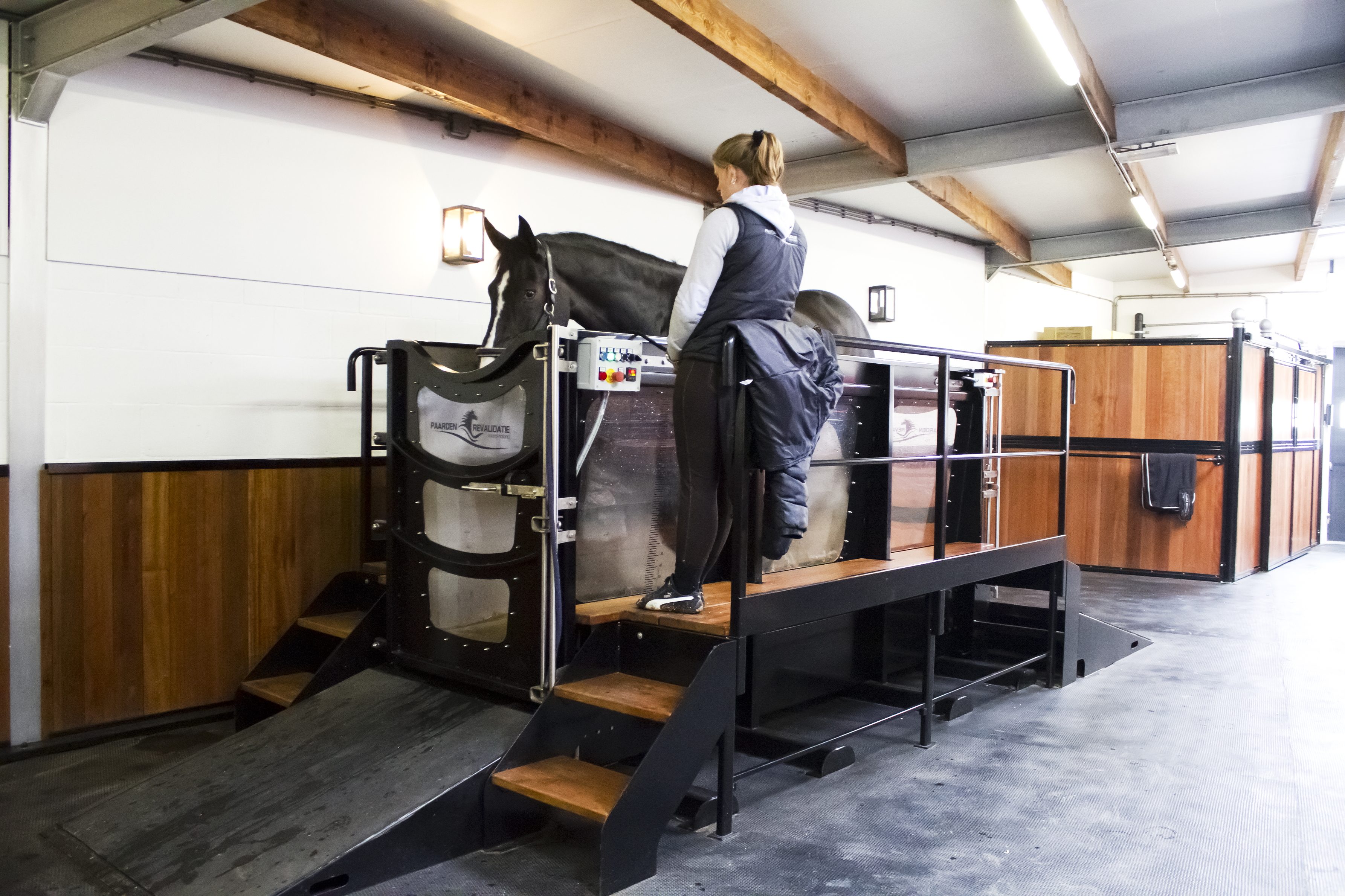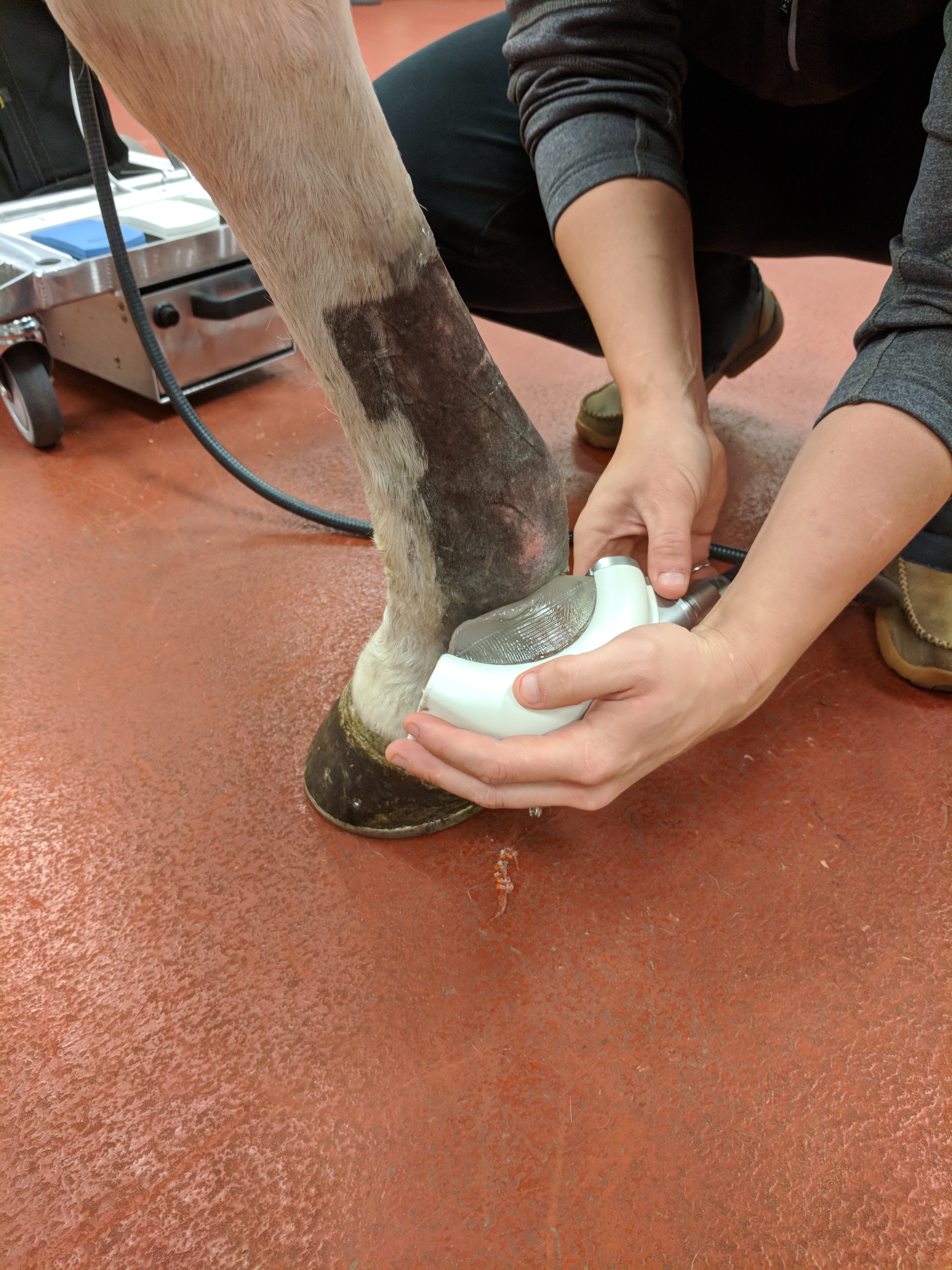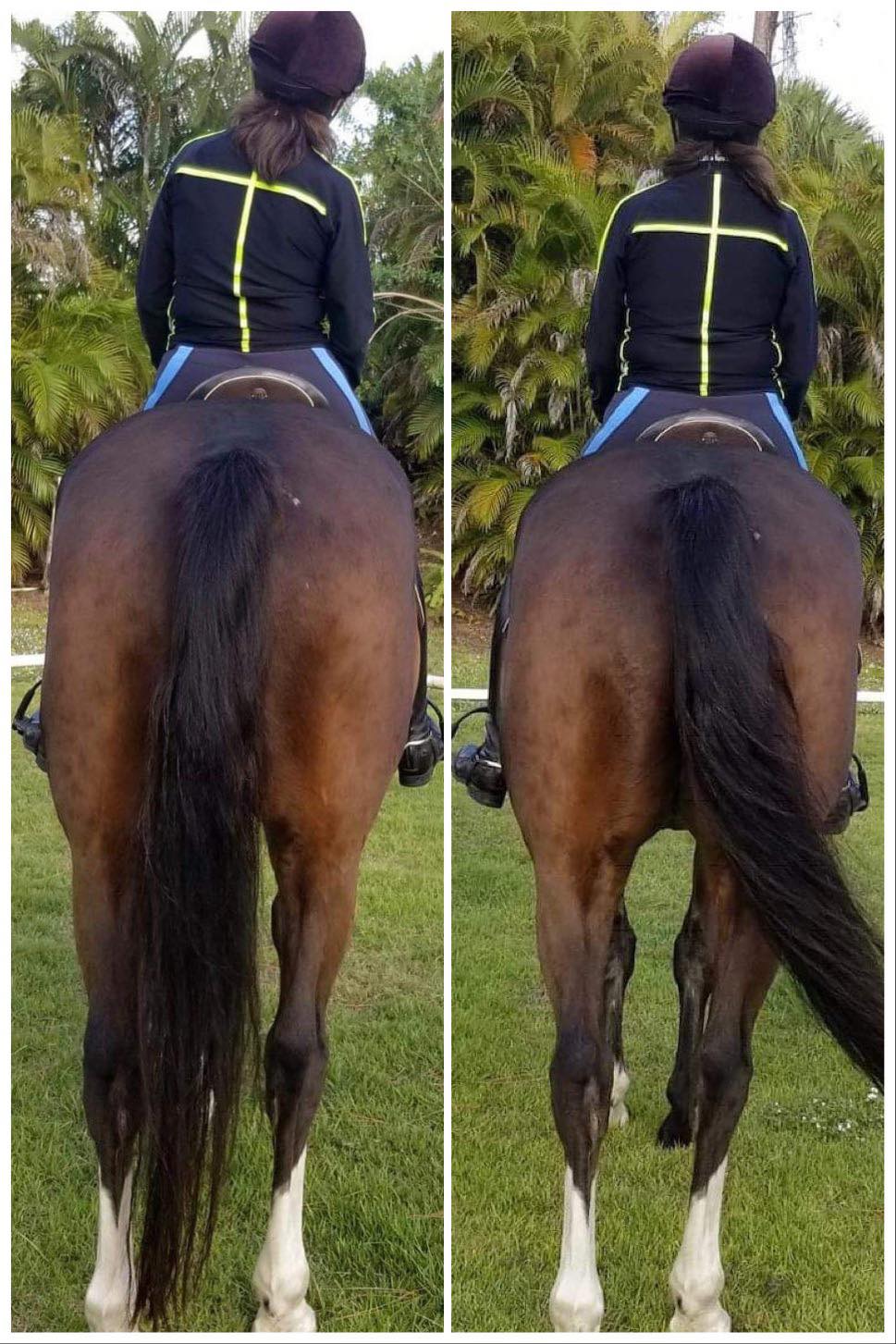
Stall rest. It’s one of the most dreaded terms in the horse world, and yet it’s been the go-to solution for healing horse injuries for years. However, thanks to a new field known as equine sports medicine and rehabilitation, stall rest is finally becoming a thing of the past. Drawing on knowledge and techniques from human physical therapy as well as a deeper understanding of equine physiology and biomechanics, this growing profession, often referred to as equine rehab (not to be confused with the general rehabilitation services rescue facilities provide for neglected and abandoned equines), provides evidence-based treatments for horses suffering from musculoskeletal and neuromuscular conditions. In layman’s terms, that means it offers scientifically proven ways to help horses heal from physical injuries and conditions that inhibit their comfort and performance.
Equine rehab complements veterinary medicine much the way that human physical therapy complements human medicine. Its methods are used to diagnose and treat both chronic conditions, like back pain, and acute injuries and lamenesses. They also help to speed up surgical recoveries. Certified equine rehab professionals can address anything from tendon and ligament injuries to restricted joint mobility, bone and tissue healing, inflammation, neurological conditions, injury prevention and even the effects of aging.
Andy Kaneps, DVM, diplomate of the American College of Veterinary Surgeons and the American College of Veterinary Sports Medicine and Rehabilitation, believes this new field is filling a void in the horse world: “In human physical therapy, any treatment modality or device needs to be approved by the Food and Drug Administration to be used. We don’t have the same level of research or regulatory restrictions in veterinary medicine. We’re always playing catch-up with studies, trying to determine ‘Does this particular methodology or device do what it claims to do?’”
That’s where equine rehab comes in. Following rigorous standards, equine rehab professionals conduct research to determine what treatment methods and devices are safe and effective. They address a full spectrum of treatments, from rehab exercise and physical manipulation (such as stretching and joint mobilization) to the appropriate use of effective modalities (such as the application of cold therapy, laser, platelets, etc.). “We all know the buzz that goes through a barn when a new gadget comes out on the market,” Dr. Kaneps says. “And any of us can go out and buy the gadget and use it.” Anecdotal information like this can be useful, he says, but to truly improve horses’ rehab outcomes, every treatment we use should undergo meaningful studies performed by unbiased researchers.
Two Educational Tracks
In the past decade or so, a handful of experts have built complementary educational tracks to address the two critical elements of the equine rehab field—research and training. One track originated in the veterinary sphere. In 2010, Dr. Kaneps and his colleagues created a program to offer board certification for licensed veterinarians interested in specializing in this field. Called the American College of Veterinary Sports Medicine and Rehabilitation (of which Dr. Kaneps is also a past president), it is recognized by the American Veterinary Medical Association and is comparable to other specialty programs offering board certification, as in surgery and internal medicine. Participants can either complete a three-year residency program at a veterinary teaching or referral hospital, or stretch the program out over six years to accommodate their day jobs.
Both the three- and six-year programs, which have produced a combined 232 board-certified specialists to date—140 of whom are equine specialists—include a research requirement and conclude with a vigorous examination, says Dr. Kaneps. “We require a hypothesis-driven publication in a scientific journal from each of our residents.”
The second educational track opens up the field to more applicants, including veterinarians, veterinary technicians, licensed human physical therapists and physical therapy assistants. Although shorter and less in-depth compared to the board-certification process, this certificate option still incorporates extensive hands-on training, a stringent final exam and a requirement to produce a well-documented case report.
There are currently only two programs in the U.S. offering this type of certificate education: the Equine Physical Rehabilitation Certificate Program at the University of Tennessee and the Animal Rehab Institute in Loxahatchee, Florida. Both incorporate online lectures and hands-on labs. The U Tenn program’s online portion takes about 60 hours; its hands-on portion is a week long. There is no time limit for completing the Animal Rehab Institute’s three online modules and live labs, but many candidates graduate within six months. Several hundred people have graduated from these programs so far and, says the head of the U Tenn program, Steve Adair, DVM, MS, diplomate of the American College of Veterinary Surgeons and the American College of Veterinary Sports Medicine and Rehabilitation, “it’s been growing exponentially in the past couple years.”

Learning From Human Physical Therapists
So what do these programs provide that traditional veterinary medicine does not? They offer more specialized diagnostic and therapeutic techniques. Dr. Kaneps credits the human physical therapy profession for much of this new direction. Whereas veterinarians have extensive training in identifying and treating equine diseases and ailments, he says, “a human-trained physical therapist has great skills in identifying things through manipulation. For example, a human-trained physical therapist can identify a muscle spasm or restriction of a joint motion that a veterinarian doesn’t have the sensitivity to find or depth of rehab knowledge to treat.”
Dr. Adair, who is also an equine chiropractor, adds, “What we are picking up from the human field are the manual therapies and therapeutic exercises.”
One of the most important aspects of human physical therapy that equine rehab is adopting is the standardization of methods and equipment. Until recently, the horse world has struggled with an abundance of non-standardized, subjective measurements, which, says Dr. Adair, “made it hard to draw any conclusions. Now, we try to use evidence-based modalities and treatments, training people on the basics of how to do it, why you use it and when you use it. We also encourage objective evaluations and record keeping, so we can keep collecting data.”
For example, many veterinarians now employ inertial-based systems to objectively measure how lame a horse is. Using three sensors attached to the horse’s head, croup and foreleg, the systems measure gait forces and symmetry to identify where the lameness is and whether it is an impact or push-off lameness. Using the resulting data, practitioners can also quantitatively measure a horse’s progress resulting from any given treatment modality. “Let’s say you’re treating a lameness using cold laser or pulse electromagnetic or the whole-body vibration plate,” says Dr. Adair. “You’d use the inertial-based system to get a baseline. Then you’d do your treatments, whatever they may be, then come back and measure again.”
This sort of scientific approach is nothing new to human physical therapists, says Arlene White, founder of the Animal Rehab Institute. After earning her bachelor’s degree in human physical therapy in the States, she completed a four-year master’s degree program in animal physiotherapy in Australia. “We start with a functional assessment,” she says, “trying to find the root of the problem, looking at the entire horse—checking his range of motion and looking for symmetry in his gaits—asking, ‘How is he compensating for that deficit?’ Then we ask, ‘How can we make him start using whatever’s wrong with him in a more normal manner?’”
The next step is to design a specific treatment protocol to heal the horse’s injury or correct his musculoskeletal or neuromotor deficiency. Human physical therapists have extensive training in hands-on treatments and exercises for promoting healing, reprogramming neuromotor pathways (retraining the nervous and muscular systems to function properly when they are “misfiring”) and increasing range of motion—always working within a pain-free range. All of these approaches can be adapted for horses.
Physical therapists’ general knowledge of human athletes can also contribute very practical information to the horse world. One basic lesson White likes to teach riders is how to train better before a competition. “They ride the horse like a mad person, trying to accomplish everything the day before the show to try to win the class. If I’m a human athlete and I’m going to run a marathon, do I run a marathon the day before? No! I take the day off; I rest, do some light stretching and light work. We have to learn this in the horse world. If you back off a bit, then you may have a better competition.”

Finding Innovative Ways to Treat Horses
Humans’ and horses’ biological systems are similar enough that much of human physical therapy can be transferred to equine rehab. However, there are enough significant differences that this transferability can never be taken for granted. For example, says White, “Since a horse has four legs instead of two, he has more ways to cheat by offloading an injured area, because he has three other legs to land on instead of one.”
Horses also have special muscles under their skin that humans don’t have. Called cutaneous trunci, they provide the twitch reflex that horses use to shake off flies. Rehab experts have learned how to take advantage of this sensitive system. White explains, “With just a little swipe of a fingernail, we can actually scratch their bellies to make them lift their backs, doing what we call a sternal lift. We do another scratch in the gluteal muscle area to get them to engage the pelvis into a pelvic tilt.”
To bridge the gap between humans and horses, the faculties of all three of this country’s current equine rehab programs include both veterinarians and physical therapists, many of whom are doing cutting-edge research, such as Dr. Hilary Clayton, an instructor at the Animal Rehab Institute, whose studies on equine locomotion have transformed the sporthorse world.
Those readers familiar with human physical therapy techniques might wonder how these experts convince horses to do all of the creative exercises that human patients do—stepping onto and off of blocks, lifting and rotating limbs, pulling on elastic bands, etc. It’s actually surprisingly easy, says White. “They are very accommodating. They’re really quite good about it.” She uses cookies to “bait” horses to do different stretches and moves, sometimes while balancing one or even two hooves on stands, thus shifting their weight to different parts of their bodies. When that’s going well, she transitions from doing the exercises on firm surfaces to doing them while standing on squares of foam. This forces a horse to further improve his balance and engagement of the core muscles, she says, “so now you’re using those muscles in a much more challenging way. Just as with humans, we are constantly progressing the exercise based on how the horse is responding.”
When horses are ready to graduate from static (standing) exercises to more dynamic ones, rehab professionals use the same elastic resistance bands that physical therapists use on humans, either around the horses’ bellies to encourage better engagement of abdominal muscles, or around the buttocks to engage the hind legs. These and other sensory-stimulation methods also help to improve a horse’s proprioception—his awareness of where he’s placing his various body parts.
Including human-trained physical therapists in this new field offers the added benefit of being able to diagnose riders’ physical problems. “It’s all a dynamic unit—the horse, saddle and rider all have to be working together,” says White. In addition to looking for pressure points caused by poorly fitting equipment, she explains, physical therapists can identify many rider problems, which can, in turn, cause problems in the horse.
For example, when one of a rider’s hip flexors is tighter than the other, her pelvis can’t maintain a neutral position in the saddle. One leg will be externally rotated and more forward-positioned than the other. This causes a weight imbalance either front to back or side to side, which throws off the horse’s center of gravity, making things like lateral movements and flying changes more difficult.
Another example is a rider with an upper-limb injury, such as a rotator-cuff tear (in the shoulder). She will tend to protect the injured side, which can lead to either an increase or decrease in rein tension. This imbalance can show up in the horse as neck stiffness or a bridle lameness (lameness that only occurs when the rider is in the saddle and unconsciously applying more rein pressure to one rein than the other, for example, while posting).
On the flip side, subtle lameness in the horse sometimes causes rider faults, Dr. Kaneps says. “Dr. Sue Dyson at the Animal Health Trust in Great Britain has clearly identified that rear-limb lameness can cause a rider to slide off to one side of the saddle.” Before this discovery, instructors told riders to solve the problem by standing down more on one stirrup. Now they know to investigate the cause further. “Using cues that we see in the rider, rather than just purely in the horse, gives us a lot more that we can use for diagnosis, also as markers for recovery.”

No More Stall Rest!
Once again, it all comes back to scientific evidence. Dr. Adair is especially excited about the research being conducted at U Tenn and other universities to study the wide range of therapeutic techniques and devices currently used in the horse world. He emphasizes the importance of substantiating all therapeutic claims with unbiased, scientifically sound studies. Dr. Kaneps adds, “We’ve made a lot of advancements, and more research is on the way.”
Equine rehab practitioners hope that this new field will one day provide the wide range of benefits offered by human physical therapy. “It is amazing,” says Dr. Adair. “People with total hip replacements—the next morning they’re up out of bed walking around.” Similar early interventions can be applied to equine tendon and ligament injuries, he says. “Instead of just standing the horse in a stall wearing a wrap, we can address the acute inflammation with things like cold and laser therapy. Then, once we get that acute inflammation out of the way, we need to start putting a little bit of stress on the tendons, then doing stuff like passive motions. There are a lot of things we could be doing to give us a better result in the end.”
Hence his motto, which easily describes this entire new profession: “Equine rehab: It’s more than stall rest.”
How to Find a Qualified Expert
Because there has been so little regulation and standardization of therapeutic techniques and modalities in the horse world, experts encourage horse owners to educate themselves as much as possible before trying any new product or hiring someone who claims to be a specialist. Misuse of such therapies can be more than just a waste of money—it can actually harm horses. “You have to be super careful about all this stuff,” says Arlene White, a licensed animal physiotherapist. For example, with therapeutic exercises, “we have to shorten the period of time that a horse works with any added device that engages new muscles and works him in a different way.” Allowing horses to go past the point of fatigue can cause physical damage.
To ensure that you’re receiving qualified information and services, seek either a board-certified specialist—identified by the letters ACVSMR after his or her name, which stand for American College of Veterinary Sports Medicine and Rehabilitation—or a certified equine rehabilitation practitioner (CERP), certified equine rehabilitation therapist (CERT) or certified equine rehabilitation assistant (CERA). In addition, a handful of professionals have degrees in animal physiotherapy. (Unfortunately, only two institutions in the world currently offer such a program, in Great Britain and South Africa.) Check the credentials on your expert’s website or ask to see his or her license.
Because of certain organizations’ proprietary use of the terms “physical therapist” and “physiotherapist”—or “physio”—legitimate animal rehab professionals can’t legally call themselves “equine physical therapists” or “equine physios.” So beware of anyone who does!
Every state in the country has its own unique laws regulating who can practice equine sports medicine and rehab legally. Many require a practitioner to either be a veterinarian or to work under the supervision of a veterinarian. To learn more about your state’s specific guidelines, search online for its “veterinary practice act” or “professional licensing boards.”
Alternatively, you can search for a board-certified diplomate in your area by going to vsmr.org. The Animal Rehab Institute lists its certified graduates at education.animalrehabinstitute.com and the University of Tennessee, which also offers certification for many other animals, including dogs, farm animals and exotic species, lists its graduates at shop.utvetce.com/cerp-equine-practitioners.









